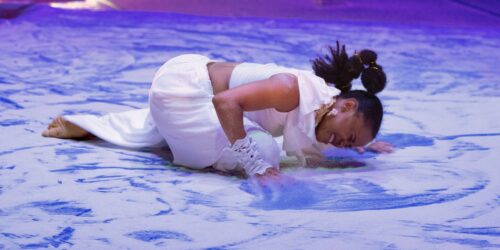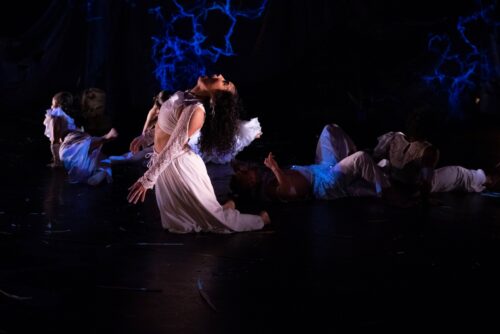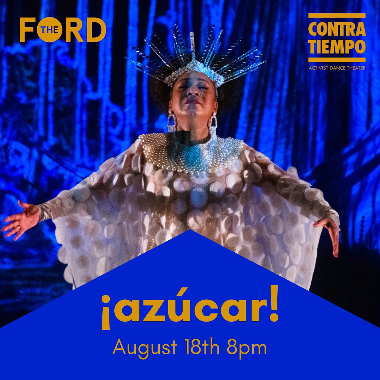GET UP AND DANCE!
I was fifteen, watching the musical Hair, when I last remember getting up out of my seat and dancing with performers at a show. I’ve always found that moment (you know the one I’m referring to, dancers inching closer to you, extending their hands, inviting you to participate) a mortifying one; so much of the joy of spectating is the promise that you will be allowed, even expected, to do just that. But in the final euphoric moments of ¡azúcar!, performed live by LA-based dance company CONTRA-TIEMPO at The Ford on Friday night, I found myself dancing in the aisles, clapping alongside the whole audience and the dancers, without remorse. For lack of a less California way to describe it, the vibes were simply that good.
Kati Hernandez ("Celeoshun, the goddess"), Jannet Galdamez ("cielo"), Jasmine Stanley-Haskins ("see-see"), Alék G. Lopéz ("pi"), Edgar Aguirre ("jelik’ laj b’alam") in ¡azúcar!
¡Azúcar! is not all sunshiny vibes and dancing in the aisles. Choreographed by Ana Maria Alvarez in collaboration with her dancers, the piece (“azúcar” is Spanish for “sugar”) abstractly traces the history of sugar as the Caribbean cash crop, as it intersects with the transatlantic slave trade, plantation cultivation, and Black and Latino diasporas. The piece begins with the 20 dancers in the audience, flitting in and out of the aisles, as we take our seats. Dressed in all-white ensembles embellished with lace and mesh, the dancers run and hug each other, tousling. They do headstands on unoccupied seats and merengue up and down the aisles. Against the wild natural backdrop of the outdoor Ford stage, a regal woman in headscarf (Cathy Hernández as “celeoshun”) glides across the proscenium. The lights dim. The dancers all make their way up to the stage slowly as if called in a trance. They take their places in three formations.
 Jasmine Stanley-Haskins as "see-see"
Jasmine Stanley-Haskins as "see-see"
For the next hour, we watch the dancers perform a mixture of contemporary, modern, merengue, hip-hop, and other indigenous/diasporan styles in different formations. They interact with ever more creative props and perform against a projection (lights designed by Tuce Yasak; projections by Meena Murugesan) onto the rock wall behind the stage. At one point the dancers swivel their hips in precise patterns, making love to stalks of sugar cane as their dance partners. At another, two women romp through layers of sugar poured out onto a tarp, a moonlight ode to delicious mischief. The projection and audio are also used tastefully to situate the dance among its historical elements. A line from Resmaa Menakem’s 2017 book My Grandmother’s Hands is projected onto the rock: “History lives in and through our bodies right now, and in every moment.” A sober voice interrupts the drumming and singing to murmur a description of a 1739 slave rebellion; captors, we’re told, jumped overboard with yelps of “exaltation.” The dancers erupt into whoops and double over with laughter, which then becomes lamentation and then morphs again into full-body seizures.
 Ruby Morales as "be(e)"
Ruby Morales as "be(e)"I don’t want to spoil too many of the unexpected twists and turns, crafted with all elements available to Galvez: formations, choreography, tempo, the unique Ford stage environment, facial expressions, sounds, props, projection, music (composers Rashaan Carter, Anaïs Maviel), and fashion (David Israel Reynoso). ¡Azúcar! is the rare performance piece which utilizes the Zeitgeisty choreographic format of constant dance (of formations blending seamlessly and abstractly into other formations) to its greatest effect. Watching, one is never sure what to expect next, but feels in safe hands, knowing that it will be moving, visually interesting, and warm-hearted.
 Jannet Galdamez as "cielo"
Jannet Galdamez as "cielo"If there is criticism to be made, it is only that the abstract nature of the dance, punctuated by the historicity of the projection and audio, doesn’t clearly articulate a single point or series of points. In the talkback held after the performance, an audience member asked Galvez what she meant to portray. She passed her microphone to dancers, who mentioned ancestors, history, of embodied historical feeling and knowledge, but the question spoke louder than their responses. That said, the piece was successful in that even I, as a person whose ancestry is recorded, was fully convinced that history lives in our bodies. It would be impossible to walk away from the performance without a profound, ancestral, yet warm feeling, even if one cannot pinpoint in language exactly what that is.
photos by Robert Davezac


